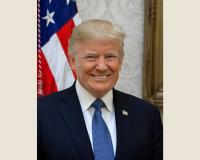Explained: What the US Retaliatory Tariffs on Indian Goods Mean for India

New Delhi, April 3 – The United States has announced a retaliatory import tariff of 27 percent on goods imported from India, raising concerns about its impact on trade between the two countries. According to experts, while these tariffs will pose challenges for Indian exporters, India is still relatively better positioned compared to some of its regional competitors who face even higher duties.
As per agency report, the newly imposed tariffs are part of a broader protectionist policy by the US aimed at reducing trade deficits and boosting domestic manufacturing. These tariffs apply to a range of goods including steel, aluminum, and automobile components, which already faced duties up to 25 percent. From April 5 to 8, an additional baseline tariff of 10 percent will be imposed on other Indian goods, increasing to 27 percent from April 9.
The US administration believes that these duties will encourage domestic manufacturing and address trade imbalances, particularly with countries like China. In the case of India, the US had a trade deficit of $35.31 billion in 2023–24, prompting its inclusion in the list of over 60 affected countries.
However, essential and strategic goods such as pharmaceuticals, semiconductors, copper, and energy products including oil, gas, coal, and LNG have been exempted from the tariff hike. Industry analysts note that these exemptions highlight the critical role of these sectors in global supply chains and public health.
India’s Ministry of Commerce is currently assessing the impact of these tariffs, with officials noting that while the move presents challenges, it is not considered a major shock. The Federation of Indian Export Organisations (FIEO) has acknowledged the concerns but pointed out that India remains in a comparatively advantageous position. For example, the US has imposed 54 percent tariffs on Chinese imports, 46 percent on Vietnamese goods, 37 percent on Bangladeshi exports, and 36 percent on goods from Thailand.
Exporters have expressed hope that the proposed India-US bilateral trade agreement could help cushion the blow of these tariffs. Discussions on this agreement began during Prime Minister Narendra Modi’s visit to the US in February, with a goal to finalize the first phase by autumn this year. The agreement aims to increase bilateral trade to $500 billion by 2030 and would include tariff reductions and measures to promote investment and service exchange.
India has been the US’s largest trading partner from 2021-22 through 2023-24, accounting for around 18 percent of India's exports and over 10 percent of its total bilateral trade. In 2023-24 alone, India recorded a trade surplus of $35.32 billion with the US. Key Indian exports to the US include pharmaceuticals ($8.1 billion), telecom equipment ($6.5 billion), precious stones ($5.3 billion), petroleum products ($4.1 billion), jewelry ($3.2 billion), cotton garments ($2.8 billion), and iron and steel products ($2.7 billion).
On the import side, India sources crude oil ($4.5 billion), petroleum products ($3.6 billion), coal and coke ($3.4 billion), processed diamonds ($2.6 billion), electrical machinery ($1.4 billion), aircraft parts ($1.3 billion), and gold ($1.3 billion) from the US.
Despite the challenges, the Global Trade Research Initiative (GTRI) suggests that this protectionist shift could offer India an opportunity to reposition itself in global supply chains. However, to fully capitalize on these emerging openings, India must focus on improving trade facilitation, investing in logistics and infrastructure, and ensuring policy stability.
Trade experts, including Abhijit Das, have noted that these retaliatory tariffs may violate World Trade Organization (WTO) norms, particularly the Most Favoured Nation (MFN) clause and binding tariff commitments. India could, if it chooses, raise the issue at the WTO’s dispute settlement forum.
Overall, while the US tariff announcement introduces a new layer of complexity in global trade dynamics, India’s diversified export portfolio, strategic exemptions, and ongoing trade talks offer some room for maneuver in navigating the evolving landscape.




